Research
Laser pulse shaping and coherent control
The main research direction is optimal shaping of laser pulses for control of molecular processes like ionization, fragmentation and photoassociation. The research activities recently also include investigations on optical fibers and multiphotonic excitations of biomarkers.
Control of photo-induced molecular processes received large interest when self-learning feedback loop algorithms were employed where tailored laser pulses can be generated, which drive the induced processes at a maximum yield along desired paths (see Fig. 1). An important issue in this regard investigated by our group is the information coded in the optimized laser pulse shape which supplies insight about the underlying processes [1]. Small alkali systems are suitable for this aim since they exhibit a number of bound states available for resonant transitions with weak fields which aids the theoretical description and hence the interpretation [2].
Closed loop optimizations on alkali dimers in a supersonic beam were demonstrated in our research group for maximization of the ionization yield. Further, isotopomer selective optimizations were conducted to examine the efficiency of the optimization procedure for the weak differences between the isotopic species [1]. Surprisingly large enrichment factors were found and information about the dynamics on the involved vibrational states was extracted from the optimal pulse shapes, which provided a new spectroscopical approach of yielding distinct frequency pattern on fs-time scales. These experiments were compared with optimal control calculations in order to decipher the underlying processes in detail [2].
A main aspect of our research is the development of novel optimal control methods to extract the most relevant information from the optimized laser field. One approach examined the implementation of genetic pressure within the algorithm for performing control pulse cleaning where extraneous pulse features were removed to expose the most important structures [3]. This has led also to first investigations on multi-criteria optimizations. Another method addressed parametric optimization by introducing physically relevant pulse parameters employing a computer assisted sub pulse encoding in order to narrow the search space and to aid the interpretation. Moreover, novel pulse shaper schemes for combined phase, amplitude, and polarization pulse control were developed and applied on alkali dimers, even in a parametric encoding. The results demonstrate the perspectives of adding a new dimension by including also the polarization and hence all properties of the light field in the pulse modulation [4].
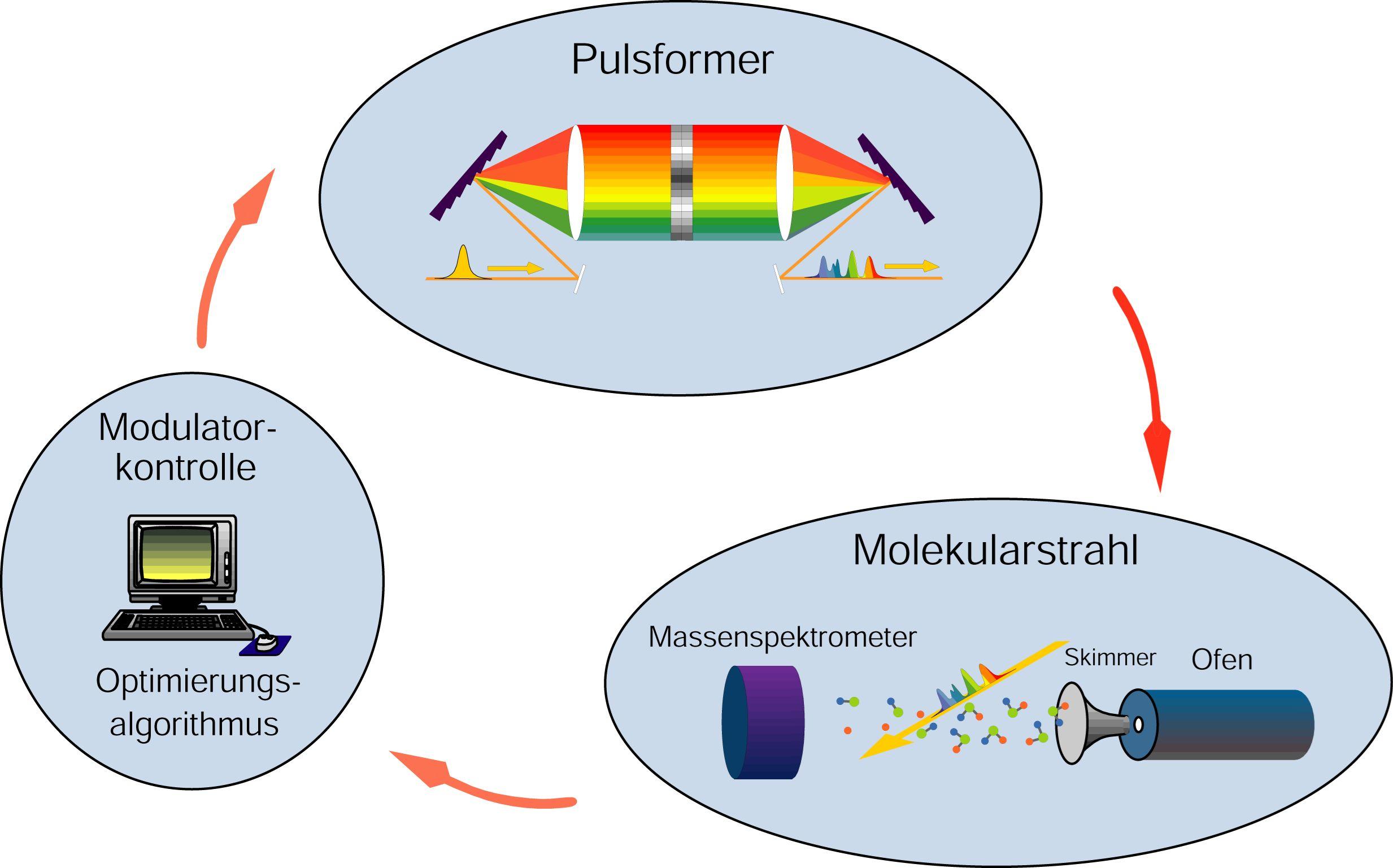
Fig. 1: Schematic setup of an optimization experiment in the gas phase. The tailored pulses are directed on the molecules and the generated ions are detected mass spectrometrically. The loop is closed by computer-aided pulse modulator control whereby evolutionary algorithms are employed.
In collaboration with Prof. M. Weidemüller, Prof. R. Wester and coworkers coherent control was also applied to ultracold trapped ensembles motivated by the perspective to perform photoassociation and photostabilization of alkali systems. First results were received regarding optimized multi-photonic excitation to molecular ions and pump-probe experiments exposing signal oscillations [5]. They provided indications for photoassociation and opened the perspective for transitions to lower vibrational levels in the electronic ground state.
In parallel, our group also conducts coherent control experiments of larger biologically relevant systems (i.e. peptides). In order to bring these fragile molecules intact into the gas phase we employed the Matrix Assisted Laser Desorption/Ionization (MALDI) method. Thereby, a laser pulse transfers the matrix-embedded molecules into the gas phase. During this process the molecules are partially ionized. Surprisingly, we found out that the MALDI-process is also possible with ultrashort laser pulses in the near infrared. This, moreover, facilitates the shaping of laser pulses for optimized extraction, ionization or fragmentation of bioligically relevant molecules and will hence lead to new results regarding control of these processes.
The current research topics are explained in the following.
Coherent control on doped, superfluid helium droplets
Helium droplets can be regarded as a unique matrix since they enable free rotation of the embedded molecules, they only marginally influence the molecular properties, and they provide efficient cooling of the internal degrees of freedom. From the spectroscopy of the embedded molecules information can be gained about the molecular structure, the interaction with the surrounding helium matrix, and about the properties of the superfluid matrix itself [6].
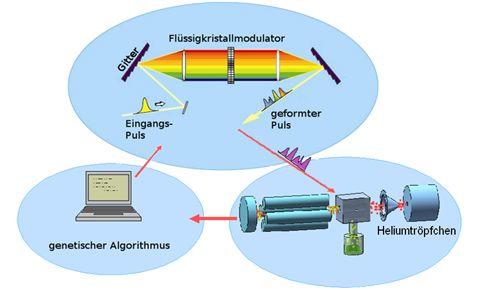
Fig. 2: Schematic experimental setup for coherent control on doped superfluid helium droplets.
The aim of the research project in collaboration with the group of Prof. Scheier (University Innsbruck) is to combine the two fields coherent control and helium droplet research by applying optimally shaped laser pulses on the doped helium droplets (see fig. 2). This opens interesting perspectives since it provides access to steer the photoinduced dynamics of van der Waals systems in the finite superfluid helium environment. The influence of the helium matrix on the molecular dynamics will thereby closely be examined, particularly regarding its superfluid properties, bubble dynamics, cage effects, relaxation processes, and decoherence properties. Particularly, photoassocitation of binary reactions starting from van der Waals clusters will be investigated. Polarization shaped laser pulses will then be employed to optimally steer the system to a covalently bound target state. This dynamics will be examined for helium-alkali atom exciplex formation with several attached helium atoms, for conversion of high spin alkali dimers and trimers to low spin configurations on helium droplets, and for transitions of more complex van der Waals systems to covalently bound species. Moreover, possible peptide bond formation will be investigated by starting from amino acid complexes.
Polarisation pulse shaping after fibers for multiphotonic excitation
Recently, we applied laser pulse shaping to optical fibers since transmission of tailored ultrashort laser pulses through photonic crystal fibers will be of practical use in different fields especially in biophysics and medicine. It allows to separate the generation of optimized pulses and the specific target or instrumentation and to transfer shaped pulses to any desired point even if it is difficult to access. This technique could be beneficial for in vivo analysis by multi-photon microscopy or photodynamic therapies. Furthermore, the confined intense light field can be used in near-field microscopy providing femtosecond time resolution.
Single mode step index fibers are very common in this research field utilizing total internal reflection for optical guiding. Yet, nonlinear effecte occur for higher pulse intensities which could strongly influence the pulse properties [7,8]. This prevents in many cases applications of the transmitted laser pulses for inducing optical processes. Novel photonic crystal fibers (PCF) were developed in the last years [9] where periodic microstructuring induces a photonic bandgap, which hinders emission of light from the fiber core. Particularly beneficial are hollow-core fibers, where the laser pulse propagates predominantely within the hollow core. This dramatically reduces dispersion and nonlinear effects like self phase modulation since only a small fraction of the light propagates through glass. It enables guiding of more energetic laser pulses in the nanojoule range through the fiber [10], which is advantageous for endoscopic two photon microscopy [11].
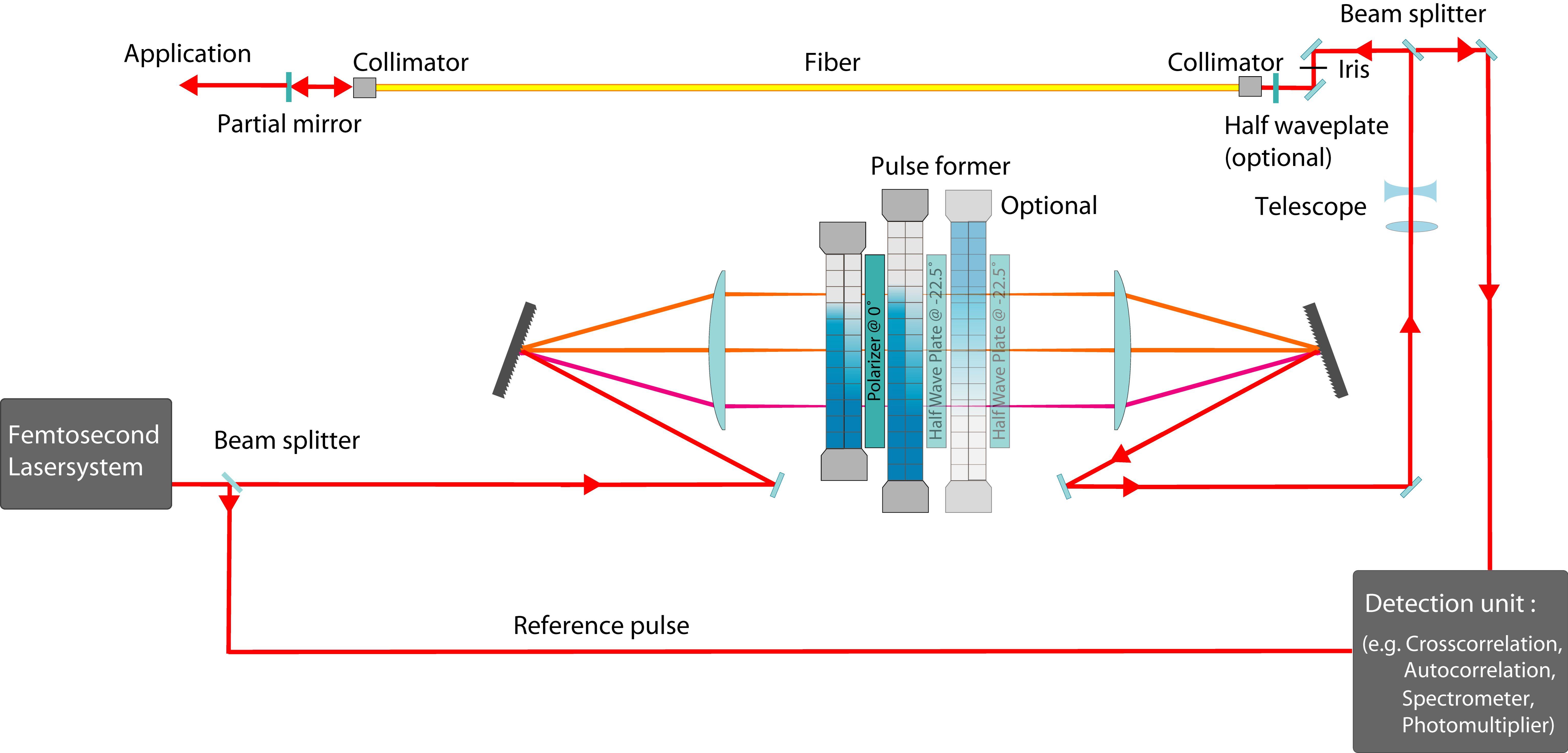
Fig. 3: The scheme shows the experimental setup including pulse former and optics with a partial mirror which partially reflects the pulse from the distal end of an optical fiber back to the proximal end where the laser pulse can be characterized.
Fig. 3 shows an exemplary embodiment of such a system for generating laser pulses after an optical fiber. In our investigations on fibers all paramters of the light field like phase, amplitude, and polarization could be modified specificly (see fig. 4). This enables to conduct adaptive optimization methods for control of molecular processes after the fiber. This was demonstrated for optimized ionization of potassium dimes in a molecular beam. A distinct enhancement of the optimization factor could thereby be obtained by also including the polarization of the laser pulses [12]. Moreover, a reflection unit is connected to the distal end of the fiber and inputs a part of the energy of laser pulses into the distal end of the fiber for transmitting them to the pulse shape measuring unit. The reflected pulses are measured by pulse shape detection which is capable of measuring the amplitude, phase, and polarization of the reflected laser pulses that exit the proximal end of the fiber. This allows to reconstruct the pulse shape at the distal end of the fiber [13], which is very advantageous for applications without space for detection at the distal end of the fiber (e.g. medical endoscopy). The pulse shape measuring unit generates parameters which are determined by using the fiber parameters for calculating the most appropriate control signal. Modifications of the fiber parameters during operation due to possible bending or twisting of the fiber can be pre-compensated online, e.g. by utilizing the reflective pulse detection method for fast adaption of the input parameters for the pulse forming unit.
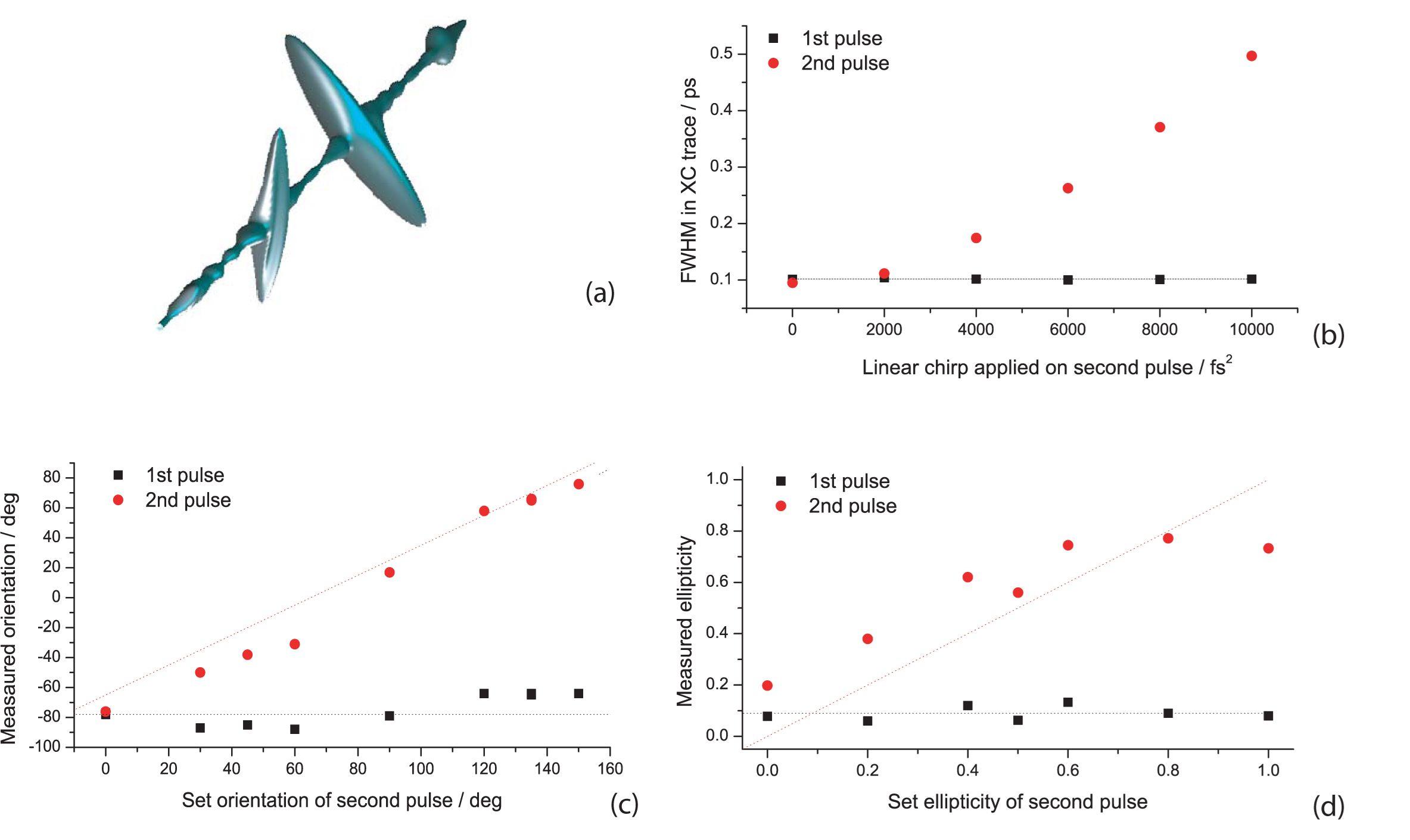
Fig. 4: Systematic representation of the pulse shaping feasibilities after a hollow core fiber. (a) 3D representation of an exemplary pulse with two linear polarized sub pulses, which are adjusted at an angle of 30° to each other. (b) Sub pulse durations for chirping the second sub pulse. (c) Sub pulse orientations for differently adjusted orientations of the second sub pulse. (d) Sub pulse ellipticities at altering the preset sub pulse ellipticty.
A main goal is to use pulse shaping methods for coherent control of multiphoton processes after transmission of polarisation shaped laser pulses through optical fibers. The tailored laser pulses enable selective multiphoton induced fluorescence of dye mixtures. Special antisymmetric phase functions were employed for scans of the multiphoton excitation. The two photon investigations could be extended to selective three photon excitations of UV dyes for contrast enhancement. Moreover, by using polarization shaping two photon transitions could selectively be excited in differing polarization directions (see fig. 5). This opens the research field of anisotropy spectroscopy, which yields informationen about mobility, size and structure of molecular aggregates also in vivo. These methods lead to improved imaging and molecular process control with specifically shaped ultrashort pulses.
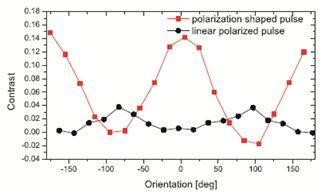
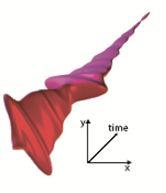
Fig. 5: Contrast improvement by a polarization shaped laser pulse. One dye will be optimally two photon excited in a certain polarization direction and the other dye in the other polarization direction.
Prospective investigations
The method development will to be continued for improved pulse shaping as well as for extraction of the most relevant information. First efforts were undertaken in this regard, as mentioned above, e. g. with simultaneous modification of phase, amplitude, and polarization which is planned to be extended to other spectral regions (IR, UV), as well as to shorter laser pulses. This will even be performed with a parametric encoding where the subpulse parameters intensities, chirps, or polarization states are subject to modulation. Thus, a larger variety in the optimal influence will be feasible. Novel Kagome fibers will be utilized for endoscopic investigations in order to guide a broader laser pulse spectrum along the fiber and moreover to transmit the induced fluorescence back through the fiber.
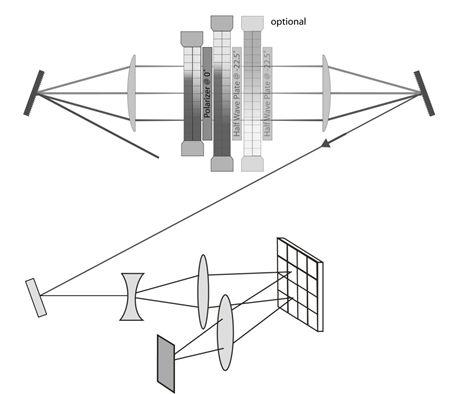
Fig. 6: Pulse shaper setup for simultaneous spatial and temporal laser pulse shaping
An interesting extension of the pulse shaping properties is simultaneous spatial and temporal laser pulse shaping (see fig. 6). It enables novel microscopic applications particularly in two photon microscopy, in nonlinear high resolution microscopy (e. g. STED), for control of molecular processes, and in surface structuring (e. g. by polymerization). This project is carried out in collaboration with the group of Prof. Dr. Heyne.
Literatur
[1] A. Lindinger, C. Lupulescu, M. Plewicki, F. Vetter, S. M. Weber, A. Merli, and L. Wöste, Phys. Rev. Lett. 93, 033001 (2004)
[2] B. Schäfer-Bung, R. Mitric, V. Bonacic-Koutecky, A. Bartelt, C. Lupulescu, A. Lindinger, S. Vajda, S. M. Weber, and L. Wöste, J. Phys. Chem. A 108, 4175 (2004)
[3] A. Lindinger, S. M. Weber, C. Lupulescu, F. Vetter, M. Plewicki, A. Merli, L. Wöste, A. Bartelt, and H. Rabitz, Phys. Rev. A 71, 013419 (2005)
[4] S. M. Weber, M. Plewicki, F. Weise, and A. Lindinger, J. Chem. Phys. 128, 174306 (2008)
[5] W. Salzmann, T. Mullins, J. Eng, M. Albert, R. Wester, M. Weidemüller, A. Merli, S. M. Weber, F. Sauer, M. Plewicki, F. Weise, L. Wöste, and A. Lindinger, Phys. Rev. Lett. 100, 233003 (2008)
[6] A. Lindinger, J. P. Toennies, and A. F. Vilesov, J. Chem. Phys. 110, 1429 (1999)
[7] Nonlinear Fiber Optics, G. P. Agrawal, Academic Press, San Diego, California, USA (1995).
[8] S. W. Clark, F. Ö. Ilday, and F. W. Wise, Optics Letters 26, 1320 (2001).
[9] P. Russell, Science 299, 358 (2003).
[10] W. Göbel, A. Nimmerjahn, and F. Helmchen, Opt. Lett. 29, 1285 (2004).
[11] S.-P. Tai, M.-C. Chan, T.-H. Tsai, S.-H. Guol, L.-J. Chen, and C.-K. Sun, Optics
Express 12, 6122 (2004).
[12] F. Weise, G. Achazi, and A. Lindinger, Phys. Chem. Chem. Phys. 13, 8621 (2011)
[13] G. Achazi, A. Patas, F. Weise, M. Pawłowska, and A. Lindinger, Appl. Opt. 50, 915 (2011).